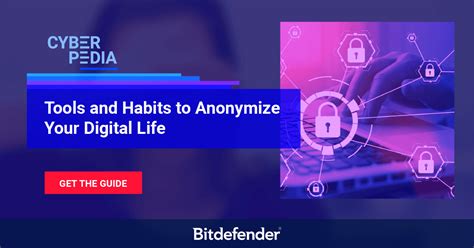Anonimity Network In Cybersecurity Article

In today's digital landscape, ensuring online privacy and security has become a paramount concern for individuals, businesses, and governments alike. With the ever-evolving threats posed by cybercriminals and surveillance agencies, the concept of an anonymity network has emerged as a powerful tool to safeguard sensitive information and protect user identities. This article delves into the intricacies of anonymity networks, exploring their mechanisms, applications, and the vital role they play in the realm of cybersecurity.
Understanding Anonymity Networks

An anonymity network, also known as an anonymous network or a privacy network, is a sophisticated system designed to shield users’ identities and online activities from prying eyes. By employing various techniques and protocols, these networks enable users to communicate and access resources on the internet without revealing their true identities or IP addresses.
The core principle behind anonymity networks is the creation of a secure and encrypted communication channel that masks users' digital footprints. This is achieved through a combination of encryption technologies, proxy servers, and decentralized network architectures. By obfuscating the source and destination of data packets, these networks ensure that user privacy remains intact, even in the face of sophisticated surveillance techniques.
Key Components of Anonymity Networks
- Encryption: Encryption is the cornerstone of anonymity networks. It involves the use of cryptographic algorithms to scramble data, making it unreadable to unauthorized individuals. Advanced encryption techniques, such as asymmetric encryption and public-key infrastructure, are employed to secure data transmission and protect user privacy.
- Proxy Servers: Proxy servers act as intermediaries between users and the internet. When a user requests a connection through a proxy server, their IP address is masked, and the server forwards the request on their behalf. This simple yet effective mechanism helps anonymize user activities by hiding their true IP addresses.
- Decentralized Network Architecture: Anonymity networks often utilize decentralized network structures, where data is routed through multiple nodes or servers. This distributed approach ensures that no single point of failure exists, making it difficult for attackers or surveillance agencies to trace the origin of data packets. The network’s complexity adds an extra layer of security and privacy.
- Onion Routing: Onion routing is a technique commonly employed by anonymity networks, particularly in the case of Tor (The Onion Router). It involves encrypting data multiple times and passing it through a series of nodes, each of which peels away one layer of encryption. This process ensures that each node only knows the previous and next hop, maintaining user anonymity.
Applications of Anonymity Networks

Anonymity networks find widespread applications across various sectors, offering unparalleled privacy and security benefits. Some of the key use cases include:
Secure Communication
One of the primary applications of anonymity networks is secure communication. Journalists, activists, and whistleblowers often rely on these networks to protect their identities and sensitive information when communicating with sources or publishing stories. By masking their digital footprints, they can ensure their safety and the integrity of their work.
Additionally, anonymity networks provide a safe haven for individuals living under repressive regimes, allowing them to access censored information and freely express their opinions without fear of retribution.
Protecting Privacy Online
In an era where personal data is a valuable commodity, anonymity networks empower individuals to take control of their privacy. By using these networks, users can prevent their online activities from being tracked, monitored, or sold to third parties. This is particularly crucial for those concerned about targeted advertising, identity theft, or government surveillance.
Bypassing Internet Censorship
Anonymity networks are instrumental in circumventing internet censorship and geo-restrictions. In countries where certain websites or online services are blocked, these networks provide a means to access restricted content. By routing data through servers located in different regions, users can overcome censorship barriers and enjoy a more open internet experience.
Secure Browsing and Data Protection
Anonymity networks offer enhanced security for everyday internet browsing. When users connect to the internet through these networks, their browsing activities are encrypted and anonymized. This protection extends to personal data, preventing unauthorized access and potential data breaches.
For businesses, anonymity networks can be a critical component of their cybersecurity strategy. By employing these networks, companies can ensure that sensitive corporate data remains secure during transmission and prevent unauthorized access to their internal networks.
Performance and Challenges
While anonymity networks provide robust privacy and security, they are not without their challenges. One of the primary concerns is the potential impact on internet speeds. As data packets are routed through multiple nodes and layers of encryption, latency can increase, resulting in slower browsing experiences.
Furthermore, the decentralized nature of these networks can make them susceptible to certain types of attacks. Malicious nodes within the network can potentially intercept and manipulate data, although various measures are in place to mitigate these risks.
Another challenge lies in the legal and ethical implications of anonymity networks. While they are valuable tools for protecting privacy, they can also be misused for illegal activities such as cybercrime, hacking, or the distribution of illicit content. Striking a balance between privacy and accountability remains an ongoing challenge for policymakers and law enforcement agencies.
Future Implications
As technology advances and cyber threats evolve, the role of anonymity networks in cybersecurity is likely to become even more critical. With the increasing reliance on digital communication and the growing sophistication of surveillance techniques, these networks will continue to be a vital tool for safeguarding user privacy and security.
Ongoing research and development in the field of anonymity networks aim to enhance their performance, scalability, and security. Innovations such as blockchain-based routing protocols and quantum-resistant encryption are being explored to further strengthen the resilience of these networks against emerging threats.
| Anonymity Network | Key Features |
|---|---|
| Tor (The Onion Router) | Onion routing, decentralized network, widely used for privacy and circumventing censorship. |
| I2P (Invisible Internet Project) | Anonymous peer-to-peer network, focusing on secure communication and data sharing. |
| Freenet | Distributed file sharing and publishing platform, ensuring anonymity and censorship resistance. |
| Tails (The Amnesic Incognito Live System) | Live operating system designed for privacy, based on Tor and other anonymity tools. |

How does an anonymity network protect user privacy?
+Anonymity networks employ various techniques such as encryption, proxy servers, and decentralized architectures to mask users’ IP addresses and online activities. This prevents surveillance agencies, cybercriminals, and other third parties from tracking and identifying users.
Are anonymity networks legal to use?
+The legality of anonymity networks varies across jurisdictions. While they are generally legal for personal use, certain countries may have restrictions or prohibitions in place. It’s essential to understand the local laws and regulations before utilizing these networks.
Can anonymity networks be used for illegal activities?
+Like any tool, anonymity networks can be misused for illegal purposes. However, their primary purpose is to protect user privacy and facilitate secure communication. Responsible use and adherence to legal guidelines are essential to ensure the integrity of these networks.
What are the potential risks associated with anonymity networks?
+While anonymity networks offer robust privacy, they may also introduce challenges such as slower internet speeds and potential security vulnerabilities. Additionally, the legal and ethical implications of using these networks must be carefully considered.



